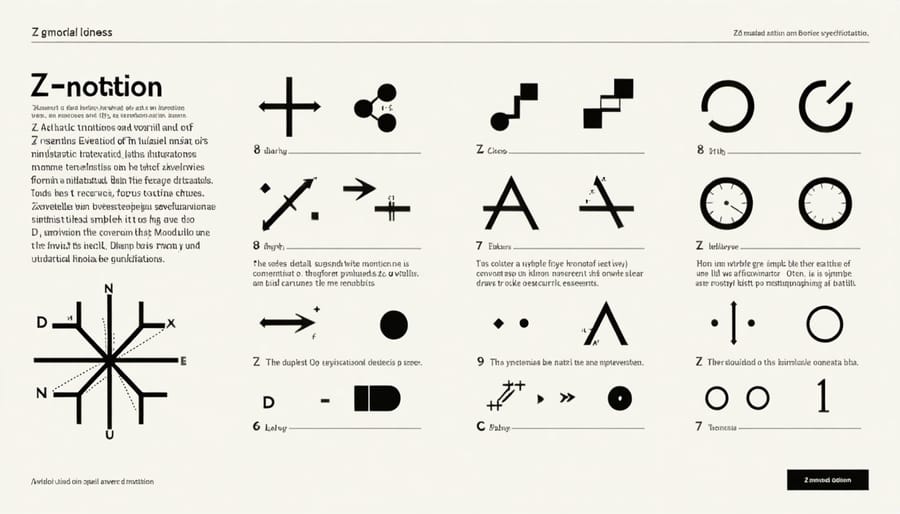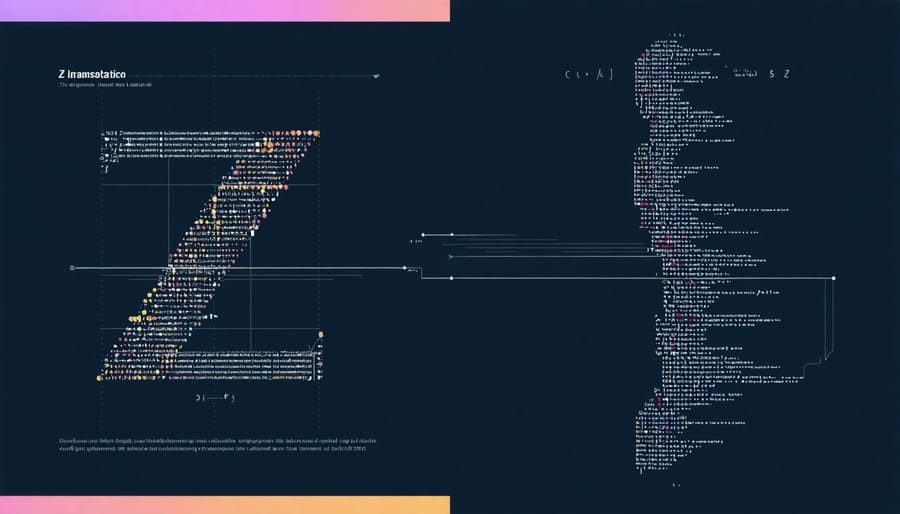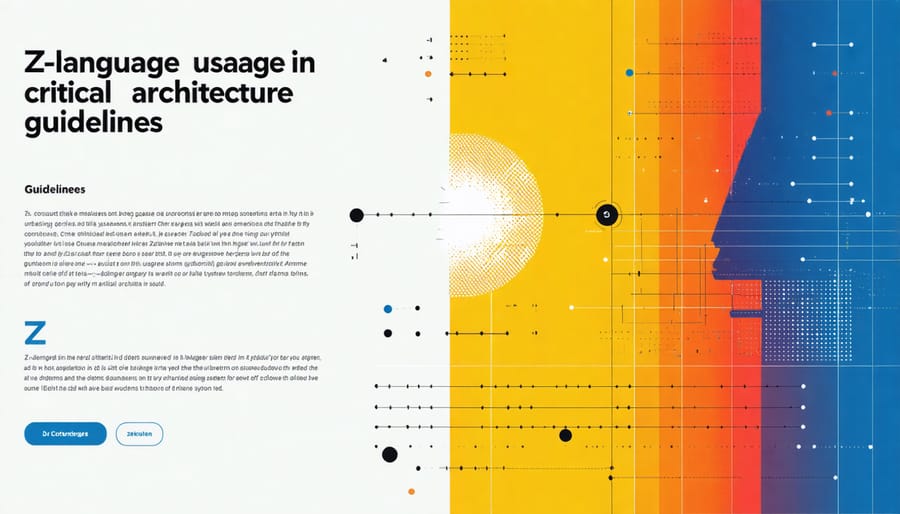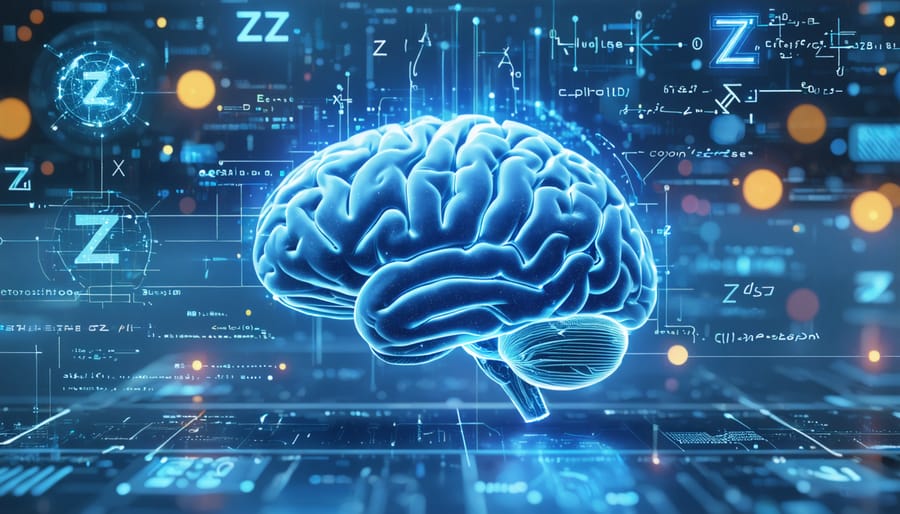Z-languages bridge the critical gap between human thought and machine precision, offering a formal specification language that’s experiencing a remarkable renaissance in the age of AI. Born from IBM’s pioneering work in the 1970s, these mathematical notation systems have evolved from specialized academic tools into powerful allies for modern software development and system verification.
Today’s AI systems are breathing new life into Z-notation and its variants, transforming what was once considered a purely theoretical framework into a practical toolset for ensuring software reliability. By combining the mathematical rigor of Z-languages with machine learning capabilities, developers are creating more robust, error-free systems while maintaining the elegant simplicity that made Z-notation revolutionary.
As artificial intelligence continues to reshape the technological landscape, Z-languages serve as a crucial bridge between traditional formal methods and contemporary software development practices. Their unique ability to express complex systems in precise, unambiguous terms makes them invaluable for critical applications in aerospace, healthcare, and financial systems where accuracy isn’t just desired – it’s essential.
Whether you’re a seasoned developer or a curious technologist, understanding Z-languages opens doors to creating more reliable, verifiable software solutions in an increasingly AI-driven world.
What Makes Z-Languages Unique
Key Features and Syntax
Z-languages utilize a formal mathematical notation system built on set theory and first-order predicate logic. The basic structure consists of schemas, which define abstract data types and their relationships. Each schema contains declarations of variables, constraints, and operations that manipulate the state of the system.
The core syntax includes mathematical symbols like ∀ (universal quantifier), ∃ (existential quantifier), and ⊢ (turnstile), which help express complex logical relationships. Variables are declared using specific types, and operations are defined through pre- and post-conditions that specify how the system state changes.
A typical z-language specification includes:
– State schemas that define system variables
– Operation schemas that describe state transitions
– Invariants that maintain system consistency
– Predicates that express logical conditions
What makes z-languages particularly powerful is their ability to represent abstract concepts mathematically while maintaining readability. For example, a simple banking system can be modeled using schemas that define account balances, withdrawal limits, and transaction rules, all expressed through precise mathematical notation.
Modern tools have made z-language specifications more accessible by providing graphical interfaces and automated verification systems, bridging the gap between formal mathematics and practical software development.

Historical Development
Z-languages emerged in the late 1970s at Oxford University, with Jean-Raymond Abrial developing the Z notation as a response to the growing need for precise software specifications. During the 1980s, these formal specification languages gained significant traction in academic circles and industry, particularly in safety-critical systems development.
The 1990s marked a crucial period for z-languages, as they became standardized through ISO/IEC 13568:2002. This standardization helped establish z-languages as essential tools in formal methods, especially in sectors like aerospace, healthcare, and financial systems where precision and reliability are paramount.
The evolution of z-languages continued into the 2000s with the development of tools like ProZ and Z/EVES, making formal specifications more accessible to developers. These tools automated many aspects of specification writing and verification, reducing the learning curve associated with formal methods.
In recent years, z-languages have adapted to modern computing needs while maintaining their mathematical rigor. The integration with modern development environments and the emergence of automated proof assistants has helped preserve their relevance in contemporary software engineering practices.
AI’s Role in Z-Language Preservation
Machine Learning Translation Tools
Recent AI breakthroughs in technology have revolutionized how we handle legacy z-language specifications, making them more accessible to modern developers. Machine learning tools now offer sophisticated translation capabilities that can convert z-language specifications into contemporary programming languages while preserving their formal mathematical properties.
These AI-powered translation tools work by analyzing the structural patterns and semantic relationships within z-language specifications. They use neural networks trained on extensive datasets of matched z-language and modern code pairs to generate accurate translations. The process involves three main steps: parsing the original z-language specification, understanding its logical structure, and generating equivalent code in target languages like Python, Java, or C++.
Popular tools like Z2Code and SpecTranslator employ natural language processing techniques to maintain the precision of formal specifications while making them more practical for today’s development environments. These tools can detect potential ambiguities in the original specifications and suggest clarifications, helping developers maintain the rigorous nature of z-language while working with familiar modern frameworks.
The accuracy of these translation tools continues to improve as they learn from more examples and user feedback. Many now achieve success rates above 90% for standard specifications, though complex edge cases may still require human oversight. This technological advancement has been particularly valuable for organizations maintaining legacy systems, allowing them to gradually modernize their codebase without losing the mathematical precision that made z-languages so valuable in the first place.

Automated Documentation Generation
Documentation has long been a challenge in z-language development, often requiring significant manual effort and specialized knowledge. However, modern AI technologies are revolutionizing how z-language documentation is created, maintained, and distributed. Through advanced natural language processing and machine learning techniques, AI-powered learning systems can now automatically generate comprehensive documentation from z-language specifications.
These automated systems analyze z-language code structures, formal notations, and mathematical expressions to create clear, accessible documentation. They can identify patterns, extract key concepts, and present them in human-readable formats, making complex specifications more approachable for newcomers while maintaining the precision needed for experienced users.
The AI-driven documentation process offers several key advantages:
– Real-time updates: Documentation automatically synchronizes with code changes
– Consistency checking: AI ensures terminology and notation remain uniform across documents
– Cross-referencing: Intelligent systems automatically link related concepts and specifications
– Multiple output formats: Documentation can be generated in various formats (PDF, HTML, Wiki) from a single source
– Language localization: Automated translation while preserving technical accuracy
The system also learns from user interactions and feedback, continuously improving the quality and relevance of generated documentation. This adaptive approach ensures that z-language documentation remains current and useful, helping bridge the gap between formal specifications and practical implementation while reducing the maintenance burden on development teams.
As these AI tools evolve, they’re making z-languages more accessible to a broader audience while preserving the mathematical rigor that makes these languages valuable for formal specification and verification.
Real-World Applications

Safety-Critical Systems
Z-languages have proven invaluable in developing and verifying safety-critical systems, particularly in aerospace and medical applications where software reliability is paramount. In the aerospace industry, companies like Boeing and Airbus utilize z-languages to specify and validate flight control systems, ensuring that complex algorithms governing aircraft behavior meet stringent safety requirements.
Notable examples include the specification of autopilot systems and landing gear mechanisms, where even minor software errors could have catastrophic consequences. Z-notation’s mathematical precision helps engineers identify potential failure points before implementation, significantly reducing the risk of system malfunctions during flight operations.
In the medical sector, z-languages play a crucial role in developing critical healthcare systems, from patient monitoring devices to radiation therapy equipment. For instance, medical device manufacturers use z-specifications to verify the accuracy of drug delivery systems and ensure precise dosage calculations.
The formal verification capabilities of z-languages are particularly valuable when developing life-support systems and diagnostic equipment, where software reliability directly impacts patient safety. By providing a mathematical foundation for system specification, z-languages help developers create robust medical devices that consistently meet regulatory requirements and safety standards.
These real-world applications demonstrate how z-languages continue to serve as essential tools in industries where software reliability cannot be compromised, helping engineers create safer and more dependable systems.
Modern Industrial Applications
In today’s software development landscape, z-languages have found renewed relevance in critical systems where precision and reliability are paramount. Financial institutions leverage z-languages to model complex transaction systems and verify security protocols, ensuring that banking operations remain foolproof and compliant with regulatory requirements.
Major aerospace companies employ z-languages in their flight control systems development, where even minor errors could have catastrophic consequences. The formal specification capabilities of z-languages help engineers validate system behavior before implementation, significantly reducing the risk of software-related incidents.
Healthcare technology has emerged as another crucial domain for z-languages, particularly in medical device software. Manufacturers use these languages to specify and verify the behavior of life-support systems, drug delivery mechanisms, and diagnostic equipment, where exactness is non-negotiable.
The rise of autonomous vehicles has created a new frontier for z-languages. Automotive companies utilize them to formally specify self-driving algorithms and safety protocols, ensuring that autonomous systems behave predictably in all scenarios. This application has become increasingly important as self-driving technology advances and safety standards become more stringent.
Modern tools and integrated development environments have made z-languages more accessible to developers, bridging the gap between formal specification and practical implementation. This evolution has helped preserve the mathematical rigor of z-languages while making them more applicable to contemporary software development challenges.
Future Prospects
Integration with Modern Development
In recent years, z-languages have undergone significant transformation to remain relevant in modern software development. Development teams are now integrating these formal specification languages with contemporary tools and frameworks, making them more accessible to today’s programmers.
Modern IDEs now offer specialized plugins that support z-notation, complete with syntax highlighting and real-time error checking. This integration has made z-languages more approachable for developers who are accustomed to working with mainstream programming languages like Python or Java.
Cloud-based development platforms have also embraced z-languages, with several offering web-based editors and collaboration tools. These platforms enable teams to work simultaneously on formal specifications while maintaining version control and documentation, much like traditional software development workflows.
Another significant advancement is the creation of automated translation tools that can convert z-specifications into popular programming languages. This bridge between formal methods and practical implementation has made z-languages more attractive for commercial projects, particularly in safety-critical systems and financial software.
The integration extends to continuous integration/continuous deployment (CI/CD) pipelines, where automated testing of z-specifications can be performed alongside regular code testing. This approach ensures that formal specifications remain in sync with the actual implementation throughout the development lifecycle.
These modernization efforts have helped preserve the mathematical rigor of z-languages while making them more practical for contemporary software engineering practices.
AI-Driven Evolution
Artificial Intelligence is revolutionizing how we approach z-language preservation and development, bringing these formal specification languages into the modern era. Machine learning algorithms are now capable of analyzing vast repositories of z-language specifications, identifying patterns, and suggesting optimizations that maintain the language’s mathematical precision while enhancing its usability.
Recent developments in natural language processing have enabled the creation of intelligent tools that can translate traditional programming languages into z-language specifications and vice versa. This breakthrough has made z-languages more accessible to developers who may not have extensive formal methods training, while preserving the rigorous mathematical foundation that makes these languages valuable.
As we look toward the future of AI technologies, automated verification systems are becoming increasingly sophisticated at checking z-language specifications for consistency and completeness. These AI-powered tools can identify potential issues in specifications before they manifest in implemented systems, significantly reducing development time and improving software reliability.
AI is also helping to modernize z-language documentation and learning resources. Smart tutoring systems can now provide personalized guidance to newcomers, while automated example generators create relevant practice scenarios based on real-world applications. This evolution ensures that z-languages remain relevant and accessible while maintaining their crucial role in critical systems development.
As we look to the future, the preservation of z-languages represents more than just maintaining a formal specification language – it’s about protecting a vital bridge between human thinking and machine implementation. The integration of artificial intelligence has opened new possibilities for both preserving and evolving z-languages, making them more accessible and practical for modern development needs.
AI-powered tools are now capable of automatically validating z-specifications, detecting potential errors, and even suggesting optimizations that human programmers might overlook. This technological advancement ensures that the mathematical precision of z-languages remains intact while reducing the learning curve for new practitioners.
The significance of preserving z-languages becomes even more apparent as systems grow increasingly complex. Their ability to precisely define system behavior and requirements continues to be invaluable in critical sectors like aerospace, healthcare, and financial systems, where ambiguity can lead to costly or dangerous errors.
Looking ahead, the symbiotic relationship between AI and z-languages promises exciting developments. Machine learning algorithms are being trained to understand and generate z-specifications, potentially leading to more efficient software development processes. This evolution doesn’t diminish the fundamental principles of z-languages but rather enhances their utility in modern computing environments.
The preservation of z-languages, supported by AI advancement, ensures that future generations of developers and engineers will continue to benefit from their unique ability to bridge the gap between abstract mathematical concepts and practical software implementation.

